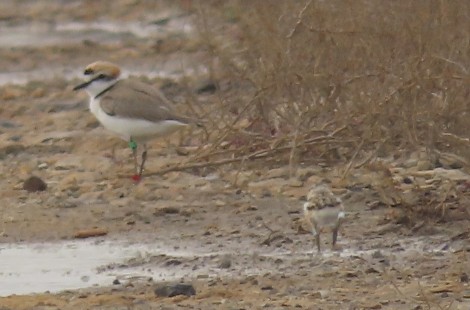
My name is Lillian and I’m a third year Natural Sciences student at Murray Edwards College. Although specialising in Chemistry in my final year, I love exploring biological subjects, especially Zoology as a part-time interest. In the past summer, I joined a bird research project held by Beijing Normal University as a fieldwork volunteer and have gained some eye-opening experience in studying birds in the wild.
The research team I was in was interested in the behavioural ecology of shorebirds, in particular the Kentish plover. There are several reasons for why we chose this bird as our research object: firstly, the Kentish plovers are ground-nesters so their nests are easy to observe; secondly, their breeding plumages are sexually dimorphic and easy to distinguish; thirdly, plovers are fairly small and easy to handle; and finally Kentish plovers are generally bold and tolerant to human disturbance.
Our research site is in a coastal salt farm at the west of Bahai Bay in north China, which is also on the East Asian-Australasian Flyway for bird migration. From early May to late September, Kentish plover, along with many waders, would breed and nest in this region. Kentish plover is polygamous: during the breeding season the males choose nesting sites and attract females that will mate and lay three eggs in the nest (a clutch), once the chicks are hatched and are old enough, one of the parents will desert the family and start finding a new mate, leaving all the parenting responsibilities to the partner. This mating pattern is what interests us the most—specifically, we want to investigate how their decision of mate or desert is influenced by ecological factors such as sex ratio, state of the current clutch and predation pressure, just to name a few.
To answer this gigantic question, we need to collect a lot of data from both the Kentish plover adults and their chicks. In order to estimate the population size and sex ratio, we use standard ringing and re-spotting method which involves capturing un-ringed individuals and putting a metal ring with a unique ID and a set of coloured plastic rings on their tarsus, as well as spotting and identifying ringed individuals in the field. To track the chicks and their parents we usually start from finding nests and estimate how old the eggs are. This provides the most accurate result as neither newly hatched chicks nor their parents tend to travel too far away from their nest. Other data we need to collect include: the sizes and weights of birds, the dimension of the eggs, DNA from the blood sample, plumage colour and breeding behaviour observations.
No two days in the field are the same, as our work is highly dependent on the weather and how many nests we’re tracking on that day. For most of the days we set off before 7 a.m. and split into two teams: team A would check the identified nests and find new ones, ring birds, collect samples and do the camera traps maintenance, while team B mainly track the ringed birds and do the behaviour observations. The evenings are normally for data logging, sample sorting and planning out the tasks for the next day.
My seven-week research in the field was intense and sometimes challenging, but I also found it rewarding because essentially I was bird-watching every single day while getting the experience of handling wild birds at the same time. What I learnt most from this volunteering experience was that interesting questions often come through practice—witnessing the behaviours that I learned from Part IB Animal Biology happen right in front of my eyes not only deepened my understanding of the theories, but also inspired me to be more curious and to come up with some hypotheses on my own.
Lillian Wang
Murray Edwards Undergraduate student